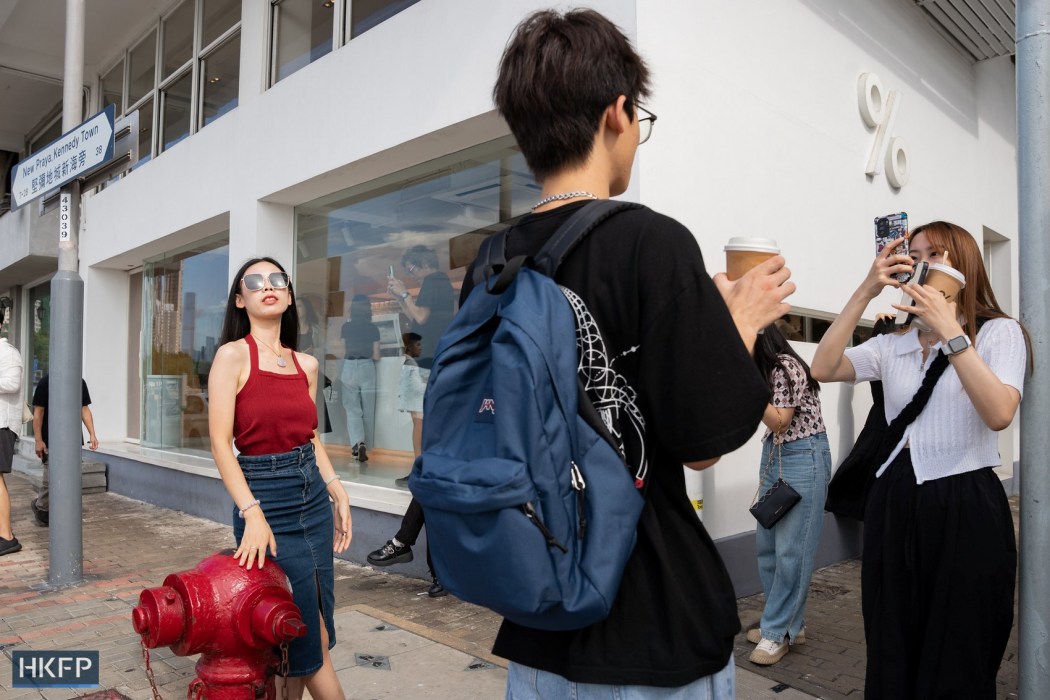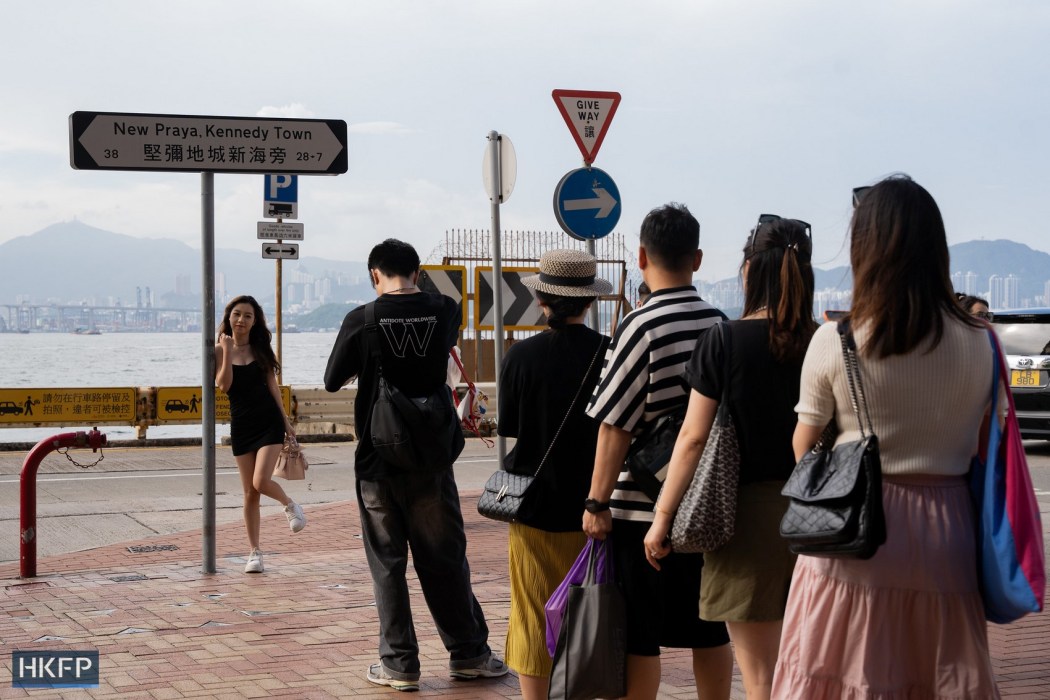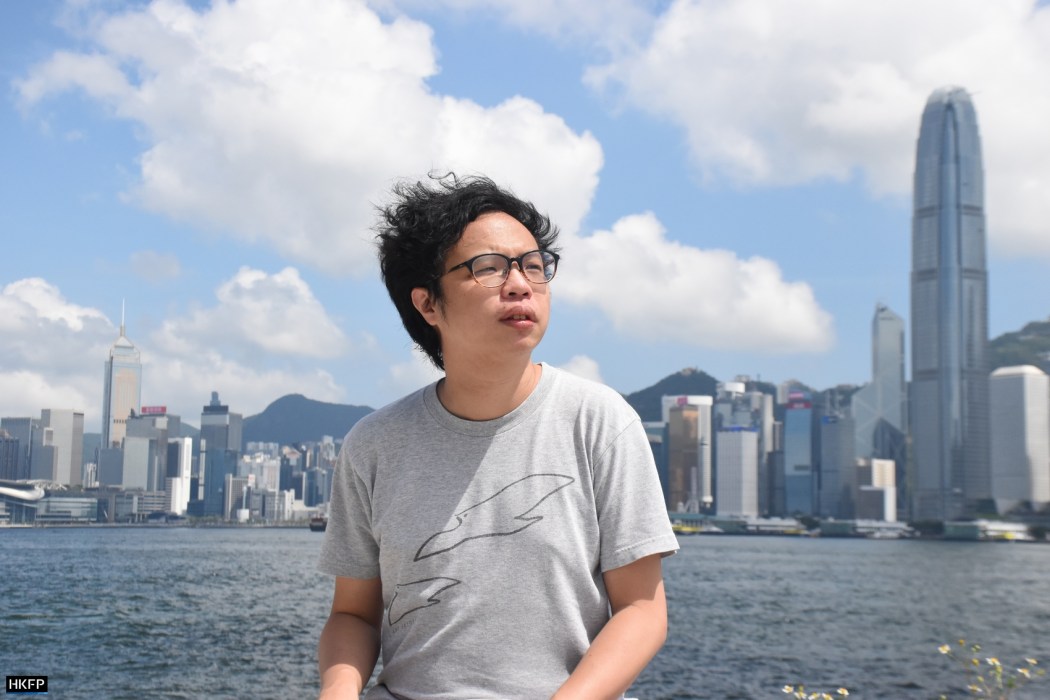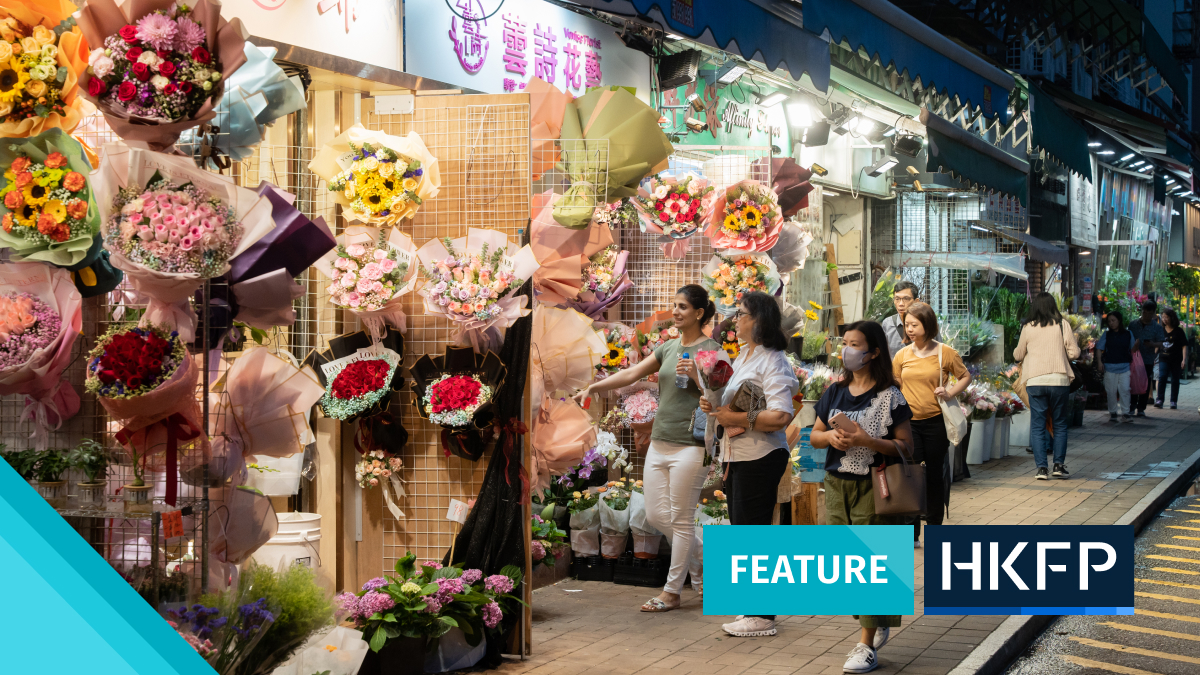Dressed in pink overalls with a matching lollipop in her mouth, mainland Chinese tourist Zeng crouched down next to a red Hong Kong taxi parked outside a waterfront coffee shop in Kennedy Town on a Friday afternoon.

Her friend, Su, took out her phone and directed Zeng on how to pose as she composed each photo. Satisfied with how the images turned out, the pair went in search of other photogenic locations around the white café, distinguished by its floor-to-ceiling glass windows.
Their place was quickly taken by another group of stylishly dressed tourists, who assumed position and began to strike different poses.
Zeng and Su were among 30-odd visitors gathered at Kennedy Town’s New Praya waterfront that cloudy August afternoon. Had the weather been bright and sunny, the crowd would probably have spilled into the road.
The area in the western part of Hong Kong Island has become a favourite among mainland Chinese tourists, who have been returning to Hong Kong since the city reopened its border and dropped its tough Covid-19 restrictions earlier this year.
Instead of lining up to shop in luxury stores in Hong Kong’s commercial heart, many visitors have turned their attention to local neighbourhoods, thanks to tens of thousands of travel guides on Chinese social media and e-commerce platform Xiaohongshu, nicknamed the Little Red Book.

Lin Jian, a digital cultures and platform studies scholar at Chinese University of Hong Kong, told HKFP earlier this month that the site, which launched in 2013, had grown in popularity during the Covid-19 pandemic, when people had to stay home under strict anti-epidemic policies.
According to Lin, while people have long used the app to find out information about particular products, they were now turning to it for travel advice. Xiaohongshu’s algorithm was “straightforward,” Lin added – by packing four posts into the screen instead of showing one at a time like other social media apps, it was able to feed more targeted content to its users.
“This is how algorithms work in general, they keep pushing related content to you, based on previous activities online, but Xiaohongshu does it in a more aggressive way,” the scholar said.
‘Citywalk’
Exploring areas on foot, either aimlessly or along a designed route to visit unique locales, has become a popular mode of travel and discovery among young mainland Chinese in the post-pandemic era. Known as “citywalk,” it places an emphasis on wandering at a slow pace, and has already amassed more than 1 million posts on Xiaohongshu.

In Hong Kong, Kennedy Town has been identified as one of the best destinations for tourists to roam, with some Xiaohongshu users calling it “the most romantic neighbourhood” in the city.
People on the app have also shown interest in the book Hong Kong Strollology by Hong Kong urbanist Sampson Wong, one of the creators behind a YouTube channel about wandering around the city “when in doubt.” The book recommends 10 routes which Wong said would make readers realise “Hong Kong is really beautiful.”
Suzanne, a 35-year-old blogger with more than 630,000 fans on Weibo, who spoke to HKFP under a pseudonym, said that last year’s frequent Covid-19 lockdowns in mainland China may have contributed to the rise of the citywalk phenomenon.
| 💡HKFP grants anonymity to known sources under tightly controlled, limited circumstances defined in our Ethics Code. Among the reasons senior editors may approve the use of anonymity for sources are threats to safety, job security or fears of reprisals. |
The Beijing-based content creator said she found comfort in walking around her neighbourhood and speaking to others when she was not forced to stay at home.
“During quarantine last year, I found it really relaxing when I got to go out to walk around, do some reading and interact with other people,” Suzanne, who requested anonymity due to fear of reprisal, said. “The opportunity for us to go out was very limited last year because the whole city was on lockdown,” she added.
“Following the stay-at-home order… I really wanted to go out and visit the park and the riverside. I really wanted to be outdoors.”
Outdoor activities such as rock-climbing, camping and fishing had also became increasingly popular in China during and after the pandemic, she said.

Mainland Chinese tourist Sue Chang, a solo traveller who also visited New Praya in August, also said the pandemic prompted people to appreciate the beauty of their neighbourhoods more, and focus on “living in the present.”
“After experiencing the pandemic, my friends and I started thinking life was rather fragile. We realised we should go out whenever we can and try to live our lives well,” the 28-year-old said in Mandarin.
Strolling became a global trend during and after the pandemic, Wong, who also teaches urban cultures and cultural geography at CUHK, told HKFP. Touring a city by roaming could help visitors’ appreciate the city’s environment more and feel its pulse, he said.
The scholar regularly monitors searches on Xiaohongshu related to walking in Hong Kong. He said his book was often mentioned when people wanted to “go deeper” with citywalk, which critics say describes consumerist behaviour of checking off certain spots and taking photos at photogenic locations.
Walking down a carefully curated route in a city often prompts people to “think more,” Wong said, such as the purpose of the walk and the route design, which would in turn deepen people’s understanding of the city.

“In the past, people may have simply shared locations for shopping and eating. But sharing a route feels like a level-up in a way, it is a more culturally sophisticated way of travelling,” he said in a Cantonese phone interview with HKFP.
‘Special forces’ travel
While sharing photographs of visually captivating destinations is common among travellers worldwide, some mainland Chinese have taken it further by adopting what they call a “special forces” itinerary.
This is an exceptionally demanding schedule that requires the traveller to brace for physical exhaustion, as they strive to cram in a multitude of activities. In extreme cases, some may even forfeit sleep to squeeze in a few more stops.
Tourists Zeng and Su, who were on a day trip to Hong Kong following a business trip in Shenzhen, told HKFP outside the café in Kennedy Town they needed to keep the interview brief. They had to cross off a few more places on their checklist before heading back to Jiangxi.
“I guess our itinerary today amounts to 50 per cent of those special forces schedules, because we are not feeling extremely tired yet,” 28-year-old Su said.

Special forces travel, a variation of low-cost travel, has become a buzzword on mainland Chinese social media sites. Controversy about this travel mode emerged in Hong Kong last month, when the Chinese University of Hong Kong refuted online claims that tourists could stay at some of its facilities overnight for free.
The “unfounded” recommendation stemmed from a guide to “free accommodation” in Hong Kong on Xiaohongshu, with the content creator pointing to places at the university with sockets for charging and a 24-hour study space where people could stay overnight.
Both CUHK scholar Lin and blogger Suzanne said China’s struggling economic recovery in the aftermath of Covid could be one reason behind a rising demand for budget travel tips.
China’s recovery was “losing steam” following a post-pandemic reopening boost, the International Monetary Fund remarked in its quarterly World Economic Outlook published in July.
Although China’s manufacturing activity and consumption services rebounded at the beginning of the year after leader Xi Jinping abandoned the zero-Covid policy, unresolved real estate problems were impacting economic revival, the international financial institution said.
Inflation in China was described by the IMF as “well below target,” as key lending rates were cut by the Chinese central bank in a bid to spur growth.

But the country saw deflationary pressure ease slightly last week as consumer prices rose by 0.1 per cent in August year-on-year compared to a 0.3 percent decrease in July.
China said on Wednesday that its economic recovery “will be a bumpy and tortuous process,” but insisted Western critics “will for sure be proven wrong.”
The mainland’s slow economic recovery has aggravated the social phenomenon of “involution,” said CUHK scholar Lin. The Chinese term “neijuan,” popularised by anthropologist Clifford Geertz in the 1960s, was used to describe an agrarian society in which increased labour did not result in a proportional output. In the context of China, it has been used to describe the intense – and sometimes unhealthy – competition among young people in the labour market.
Many people believed they did not have a choice but to “overexploit” themselves and “accept inequalities” as they strove to build a decent life, the associate professor said.
“Covid-19 really made a lot of people realise that this is not sustainable,” Lin said.
Hong Kong’s charisma
The changing preferences of mainland Chinese tourists in the post-pandemic era were noted by the Hong Kong Tourism Association last month, when its executive director Timothy Chui said visitors were now drawn to the city’s local customs, culture, and character.

Blogger Suzanne observed that the allure of Hong Kong for mainland Chinese tourists went beyond its reputation as a shopping paradise. Many individuals born between the 1980s and 2000s were deeply influenced by the city’s television dramas and films, which prompted them to want to personally experience the iconic locations showcased on screen.
“Hong Kong is a very charismatic city, with its history and its cultural industries, such as television dramas and films. Also the cityscape – it is a beautiful island, it is very different from other cities in mainland China,” she said.
Scholar Lin agreed that many people in mainland China formed their impression of Hong Kong based on films from the 1990s. Such nostalgic “Hong Kong aesthetics” could definitely be a reason why people wanted to visit the city, he said.

Although the portrayal of Hong Kong on Xiaohongshu may only highlight certain qualities of the city, Lin said the rise of this platform could help narrow the gap between Hongkongers and mainland Chinese, as discussion on various topics – including more controversial issues such as Hong Kong’s identity – could take place. Even if the discussion gets heated, it could still be beneficial to bridging understanding between people, the scholar said.
“[A]s long as you have this sort of communication, you have a place for people from different backgrounds to share their different experiences on this platform. I believe communication can really help narrow down the gap and misunderstanding,” he said.
Support HKFP | Policies & Ethics | Error/typo? | Contact Us | Newsletter | Transparency & Annual Report | Apps
Help safeguard press freedom & keep HKFP free for all readers by supporting our team

Original reporting on HKFP is backed by our monthly contributors.
Almost 1,000 monthly donors make HKFP possible. Each contributes an average of HK$200/month to support our award-winning original reporting, keeping the city’s only independent English-language outlet free-to-access for all. Three reasons to join us:
- 🔎 Transparent & efficient: As a non-profit, we are externally audited each year, publishing our income/outgoings annually, as the city’s most transparent news outlet.
- 🔒 Accurate & accountable: Our reporting is governed by a comprehensive Ethics Code. We are 100% independent, and not answerable to any tycoon, mainland owners or shareholders. Check out our latest Annual Report, and help support press freedom.
- 💰 It’s fast, secure & easy: We accept most payment methods – cancel anytime, and receive a free tote bag and pen if you contribute HK$150/month or more.
MORE Original Reporting
HKFP has an impartial stance, transparent funding, and balanced coverage guided by an Ethics Code and Corrections Policy.
Support press freedom & help us surpass 1,000 monthly Patrons: 100% independent, governed by an ethics code & not-for-profit.









